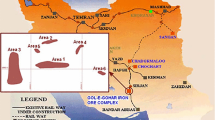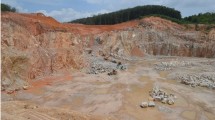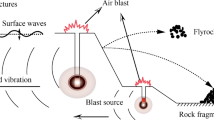Abstract
Flyrock is one of the most important environmental and hazardous issues in mine blasting, which can affect equipment and people, and may lead to fatal accidents. Therefore, prediction and minimization of this phenomenon are crucial objectives of many rock removal projects. This study is aimed to predict the flyrock distance with the use of machine learning techniques. The most effective parameters of flyrock were measured during blasting operations in six mines. In total, 262 data samples of blasting operations were accurately measured and used for approximation purposes. Then, flyrock was evaluated and estimated using three machine learning methods: principle component regression (PCR), support vector regression (SVR), and multivariate adaptive regression splines (MARS). Many models of PCR, SVR, and MARS were constructed for the flyrock distance prediction. The modeling process of each method is elaborated separately in a way to be used by other researchers. The most important parameters affecting these models were assessed to obtain the best performance for the developed models. Eventually, a preferable model of each machine learning technique was used for comparison purposes. According to the used performance indices, coefficient of determination (R2), and root mean square error, the SVR model showed a better performance capacity in predicting flyrock distance compared with the other proposed models. Thus, the SVR prediction model can be used to accurately predict flyrock distance, thereby properly determining the blast safety area. Additionally, the SVR model was optimized by new optimization algorithm namely gray wolf optimization (GWO) for minimizing the flyrock resulting from blasting operation. By developing optimization technique of GWO, the value of flyrock can be decreased 4% compared with the minimum flyrock distance.

















Similar content being viewed by others
References
Amini H, Gholami R, Monjezi M, Torabi S (2012) Evaluation of flyrock phenomenon due to blasting operation by support vector machine. Neural Comput Appl 21:2077–2085
Armaghani DJ, Hajihassani M, Mohamad ET et al (2014) Blasting-induced flyrock and ground vibration prediction through an expert artificial neural network based on particle swarm optimization. Arab J Geosci 7:5383–5396
Armaghani D, Mohamad E, Hajihassani M (2016) Evaluation and prediction of flyrock resulting from blasting operations using empirical and computational methods. Eng Comput 32:109–121
Armaghani DJ, Koopialipoor M, Marto A, Yagiz S (2019) Application of several optimization techniques for estimating TBM advance rate in granitic rocks. J Rock Mech Geotech Eng. https://doi.org/10.1016/j.jrmge.2019.01.002
Asteris PG, Kolovos KG (2019) Self-compacting concrete strength prediction using surrogate models. Neural Comput Appl 31:409–424
Asteris PG, Plevris V (2017) Anisotropic masonry failure criterion using artificial neural networks. Neural Comput Appl 28:2207–2229
Asteris PG, Nozhati S, Nikoo M et al (2018) Krill herd algorithm-based neural network in structural seismic reliability evaluation. Mech Adv Mater Struct 1–8
Bajpayee TS, Rehak TR, Mowrey GL, Ingram DK (2004) Blasting injuries in surface mining with emphasis on flyrock and blast area security. J Saf Res 35:47–57
Bhandari S (1997) Engineering rock blasting operations. A A Balkema, p 388 388
Bui X-N, Nguyen H, Le H-A et al (2019) Prediction of blast-induced air over-pressure in open-pit mine: assessment of different artificial intelligence techniques. Nat Resour Res. https://doi.org/10.1007/s11053-019-09461-0
Chahnasir ES, Zandi Y, Shariati M et al (2018) Application of support vector machine with firefly algorithm for investigation of the factors affecting the shear strength of angle shear connectors. SMART Struct Syst 22:413–424
Chen W, Sarir P, Bui X-N et al (2019) Neuro-genetic, neuro-imperialism and genetic programing models in predicting ultimate bearing capacity of pile. Eng Comput. https://doi.org/10.1007/s00366-019-00752-x
Cortes C, Vapnik V (1995) Support-vector networks. Mach Learn 20(3):273–297
Das SK, Biswal RK, Sivakugan N, Das B (2011) Classification of slopes and prediction of factor of safety using differential evolution neural networks. Environ Earth Sci 64:201–210
Emary E, Zawbaa HM, Grosan C, Hassenian AE (2015) Feature subset selection approach by gray-wolf optimization. In: Afro-European conference for industrial advancement. Springer, pp 1–13
Emary E, Zawbaa HM, Grosan C (2017) Experienced gray wolf optimization through reinforcement learning and neural networks. IEEE Trans neural Netw Learn Syst 29:681–694
Faradonbeh RS, Armaghani DJ, Amnieh HB, Mohamad ET (2016a) Prediction and minimization of blast-induced flyrock using gene expression programming and firefly algorithm. Neural Comput Appl 1–13. https://doi.org/10.1007/s00521-016-2537-8
Faradonbeh RS, Armaghani DJ, Monjezi M, Mohamad ET (2016b) Genetic programming and gene expression programming for flyrock assessment due to mine blasting. Int J Rock Mech Min Sci 88:254–264
Faradonbeh RS, Jahed Armaghani D, Monjezi M (2016c) Development of a new model for predicting flyrock distance in quarry blasting: a genetic programming technique. Bull Eng Geol Environ 75. https://doi.org/10.1007/s10064-016-0872-8
Friedman JH (1991) Multivariate adaptive regression splines. Ann Stat:1–67
Ghasemi E, Sari M, Ataei M (2012) Development of an empirical model for predicting the effects of controllable blasting parameters on flyrock distance in surface mines. Int J Rock Mech Min Sci 52:163–170. https://doi.org/10.1016/j.ijrmms.2012.03.011
Ghasemi E, Amini H, Ataei M, Khalokakaei R (2014) Application of artificial intelligence techniques for predicting the flyrock distance caused by blasting operation. Arab J Geosci 7:193–202
Guo H, Zhou J, Koopialipoor M et al (2019) Deep neural network and whale optimization algorithm to assess flyrock induced by blasting. Eng Comput. https://doi.org/10.1007/s00366-019-00816-y
Gupta RN (1980) Surface blasting and its impact on environment. Impact Min Environ. Ashish Publ House, New Delhi, pp 23–24
Hasanipanah M, Faradonbeh RS, Armaghani DJ et al (2017) Development of a precise model for prediction of blast-induced flyrock using regression tree technique. Environ Earth Sci 76:27
Hastie T, Tibshirani R, Friedman J (2009) The elements of statistical learning: data mining, inference, and prediction. Springer Science & Business Media. New York, NY
Hemphill GB (1981) Blasting operations. McGraw-Hill, New York
Huang L, Asteris PG, Koopialipoor M et al (2019) Invasive weed optimization technique-based ANN to the prediction of rock tensile strength. Appl Sci 9:5372
Jahed Armaghani D, Hajihassani M, Monjezi M et al (2015) Application of two intelligent systems in predicting environmental impacts of quarry blasting. Arab J Geosci 8:9647–9665. https://doi.org/10.1007/s12517-015-1908-2
Jekabsons G (2011) ARESLab: adaptive regression splines toolbox for Matlab/Octave. URL http//www cs rtu lv/jekabsons
Kecojevic V, Radomsky M (2005) Flyrock phenomena and area security in blasting-related accidents. Saf Sci 43:739–750
Khandelwal M, Monjezi M (2013) Prediction of backbreak in open-pit blasting operations using the machine learning method. Rock Mech Rock Eng 46:389–396
Khandelwal M, Singh TN (2005) Prediction of blast induced air overpressure in opencast mine. Noise Vib Worldw 36:7–16
Khandelwal M, Singh TN (2009) Prediction of blast-induced ground vibration using artificial neural network. Int J Rock Mech Min Sci 46:1214–1222
Khandelwal M, Kankar PK, Harsha SP (2010) Evaluation and prediction of blast induced ground vibration using support vector machine. Min Sci Technol 20:64–70
Koopialipoor M, Armaghani DJ, Hedayat A et al (2018a) Applying various hybrid intelligent systems to evaluate and predict slope stability under static and dynamic conditions. Soft Comput. https://doi.org/10.1007/s00500-018-3253-3
Koopialipoor M, Fallah A, Armaghani DJ et al (2018b) Three hybrid intelligent models in estimating flyrock distance resulting from blasting. Eng Comput. https://doi.org/10.1007/s00366-018-0596-4
Koopialipoor M, Ghaleini EN, Haghighi M et al (2018c) Overbreak prediction and optimization in tunnel using neural network and bee colony techniques. Eng Comput. https://doi.org/10.1007/s00366-018-0658-7
Koopialipoor M, Nikouei SS, Marto A et al (2018d) Predicting tunnel boring machine performance through a new model based on the group method of data handling. Bull Eng Geol Environ 78:3799–3813
Koopialipoor M, Fahimifar A, Ghaleini EN et al (2019a) Development of a new hybrid ANN for solving a geotechnical problem related to tunnel boring machine performance. Eng Comput. https://doi.org/10.1007/s00366-019-00701-8
Koopialipoor M, Ghaleini EN, Tootoonchi H et al (2019b) Developing a new intelligent technique to predict overbreak in tunnels using an artificial bee colony-based ANN. Environ Earth Sci 78:165. https://doi.org/10.1007/s12665-019-8163-x
Koopialipoor M, Jahed Armaghani D, Haghighi M, Ghaleini EN (2019c) A neuro-genetic predictive model to approximate overbreak induced by drilling and blasting operation in tunnels. Bull Eng Geol Environ 78:981–990. https://doi.org/10.1007/s10064-017-1116-2
Koopialipoor M, Murlidhar BR, Hedayat A et al (2019d) The use of new intelligent techniques in designing retaining walls. Eng Comput. https://doi.org/10.1007/s00366-018-00700-1
Koopialipoor M, Noorbakhsh A, Noroozi Ghaleini E et al (2019e) A new approach for estimation of rock brittleness based on non-destructive tests. Nondestruct Test Eval:1–22. https://doi.org/10.1080/10589759.2019.1623214
Koopialipoor M, Tootoonchi H, Jahed Armaghani D et al (2019f) Application of deep neural networks in predicting the penetration rate of tunnel boring machines. Bull Eng Geol Environ. https://doi.org/10.1007/s10064-019-01538-7
Kopp JW (1994) Observation of flyrock at several mines and quarries. In: Proceeding of 20th conference on explosives and blasting technique Austin Texas, 30 January–3 February. Cleveland International Society of Explosives Engineers, pp 75–81
Kumar A, Pant S, Ram M (2017) System reliability optimization using gray wolf optimizer algorithm. Qual Reliab Eng Int 33:1327–1335
Little TN, Blair DP (2010) Mechanistic Monte Carlo models for analysis of flyrock risk. Rock Fragm Blast 9:641–647
Lundborg N (1974) The hazards of flyrock in rock blasting. Swedish Detonic Res Found Reports DS 12
Lundborg N, Persson A, Ladegaard-Pedersen A, Holmberg R (1975) Keeping the lid on flyrock in open-pit blasting. Eng Min J 176:95–100
Mahdevari S, Shahriar K, Yagiz S, Shirazi MA (2014) A support vector regression model for predicting tunnel boring machine penetration rates. Int J Rock Mech Min Sci 72:214–229
Mahdiyar A, Jahed Armaghani D, Koopialipoor M et al (2020) Practical risk assessment of ground vibrations resulting from blasting, using gene expression programming and Monte Carlo simulation techniques. Appl Sci 10:472
Marto A, Hajihassani M, Jahed Armaghani D et al (2014) A novel approach for blast-induced flyrock prediction based on imperialist competitive algorithm and artificial neural network. Sci World J 2014
McKenzie CK (2009) Flyrock range and fragment size prediction. In: Proceedings of the 35th Annual Conference on Explosives and Blasting Technique. International Society of Explosives Engineers
Mirjalili S, Mirjalili SM, Lewis A (2014) Grey wolf optimizer. Adv Eng Softw 69:46–61
Mohamad ET, Armaghani DJ, Hajihassani M, Faizi K, Marto A (2013a) A simulation approach to predict blasting-induced flyrock and size of thrown rocks. Electron J Geotech Eng 18(B):365–374
Mohamad ET, Armaghani DJ, Motaghedi H (2013b) The effect of geological structure and powder factor in flyrock accident, Masai, Johor, Malaysia. Electron J Geotech Eng 18:5561–5572
Mohamad ET, Koopialipoor M, Murlidhar BR et al (2019) A new hybrid method for predicting ripping production in different weathering zones through in-situ tests. Measurement. https://doi.org/10.1016/j.measurement.2019.07.054
Mohammadhassani M, Nezamabadi-Pour H, Suhatril M, Shariati M (2013) Identification of a suitable ANN architecture in predicting strain in tie section of concrete deep beams. Struct Eng Mech 46:853–868
Monjezi M, Bahrami A, Varjani AY (2010) Simultaneous prediction of fragmentation and flyrock in blasting operation using artificial neural networks. Int J Rock Mech Min Sci 3:476–480
Monjezi M, Khoshalan HA, Varjani AY (2012) Prediction of flyrock and backbreak in open pit blasting operation: a neuro-genetic approach. Arab J Geosci 5:441–448
Monjezi M, Mehrdanesh A, Malek A, Khandelwal M (2013) Evaluation of effect of blast design parameters on flyrock using artificial neural networks. Neural Comput Appl 23:349–356
Monjezi M, Bahrami A, Varjani AY, Sayadi AR (2011) Prediction and controlling of flyrock in blasting operation using artificial neural network. Arab J Geosci 4(3–4):421–425
Mosavi MR, Khishe M, Ghamgosar A (2016) Classification of sonar data set using neural network trained by gray wolf optimization. Neural Netw World 26:393
Najafzadeh M, Barani G-A, Kermani MRH (2013) GMDH based back propagation algorithm to predict abutment scour in cohesive soils. Ocean Eng 59:100–106
Nguyen H, Bui X-N (2019) Predicting blast-induced air overpressure: a robust artificial intelligence system based on artificial neural networks and random forest. Nat Resour Res 28:893–907
Nguyen H, Bui X-N, Tran Q-H et al (2019) Evaluating and predicting blast-induced ground vibration in open-cast mine using ANN: a case study in Vietnam. SN Appl Sci 1:125
Rad HN, Bakhshayeshi I, Jusoh WAW et al (2019) Prediction of flyrock in mine blasting: a new computational intelligence approach. Nat Resour Res. https://doi.org/10.1007/s11053-019-09464-x
Raina AK, Murthy V, Soni AK (2014) Flyrock in bench blasting: a comprehensive review. Bull Eng Geol Environ 73:1199–1209
Rezaei M, Monjezi M, Varjani A (2011) Development of a fuzzy model to predict flyrock in surface mining. Saf Sci
Richards A, Moore A (2004) Flyrock control-by chance or design. In: proceedings of the annual conference on explosives and blasting technique. ISEE; 1999, pp 335–348
Saghatforoush A, Monjezi M, Faradonbeh RS, Armaghani DJ (2016) Combination of neural network and ant colony optimization algorithms for prediction and optimization of flyrock and back-break induced by blasting. Eng Comput 32:255–266
Singh SP (1988) Burst energy release index. Rock Mech Rock Eng 21:149–155
Sun L, Koopialipoor M, Armaghani DJ et al (2019) Applying a meta-heuristic algorithm to predict and optimize compressive strength of concrete samples. Eng Comput:1–13
Trivedi R, Singh TN, Raina AK (2014) Prediction of blast-induced flyrock in Indian limestone mines using neural networks. J Rock Mech Geotech Eng 6:447–454
Trivedi R, Singh TN, Gupta N (2015) Prediction of blast-induced flyrock in opencast mines using ANN and ANFIS. Geotech Geol Eng 33:875–891
Ulusay R, Hudson JA (2007) The complete ISRM suggested methods for rock characterization, testing and monitoring: 1974–2006. Comm Test methods Int Soc Rock Mech Compil arranged by ISRM Turkish Natl Group, Ankara, Turkey 628
Wang X, Tang Z, Tamura H et al (2004) An improved backpropagation algorithm to avoid the local minima problem. Neurocomputing 56:455–460
Wang M, Shi X, Zhou J (2018a) Charge design scheme optimization for ring blasting based on the developed scaled Heelan model. Int J Rock Mech Min Sci 110:199–209
Wang M, Shi X, Zhou J, Qiu X (2018b) Multi-planar detection optimization algorithm for the interval charging structure of large-diameter longhole blasting design based on rock fragmentation aspects. Eng Optim 50:2177–2191
Xu C, Gordan B, Koopialipoor M et al (2019) Improving performance of retaining walls under dynamic conditions developing an optimized ANN based on ant colony optimization technique. IEEE Access 7:94692–94700
Yang H, Koopialipoor M, Armaghani DJ et al (2019) Intelligent design of retaining wall structures under dynamic conditions. Steel Compos Struct 31:629–640
Zhang X, Nguyen H, Bui X-N et al (2019) Novel soft computing model for predicting blast-induced ground vibration in open-pit mines based on particle swarm optimization and XGBoost. Nat Resour Res. https://doi.org/10.1007/s11053-019-09492-7
Zhou J, Li X, Mitri HS (2015) Comparative performance of six supervised learning methods for the development of models of hard rock pillar stability prediction. Nat Hazards 79:291–316
Zhou J, Shi X, Li X (2016) Utilizing gradient boosted machine for the prediction of damage to residential structures owing to blasting vibrations of open pit mining. J Vib Control 22:3986–3997
Zhou J, Aghili N, Ghaleini EN et al (2019a) A Monte Carlo simulation approach for effective assessment of flyrock based on intelligent system of neural network. Eng Comput. https://doi.org/10.1007/s00366-019-00726-z
Zhou J, Koopialipoor M, Murlidhar BR et al (2019b) Use of intelligent methods to design effective pattern parameters of mine blasting to minimize flyrock distance. Nat Resour Res. https://doi.org/10.1007/s11053-019-09519-z
Zhou J, Li E, Wei H et al (2019c) Random forests and cubist algorithms for predicting shear strengths of rockfill materials. Appl Sci 9:1621
Zhou J, Guo H, Koopialipoor M et al (2020) Investigating the effective parameters on the risk levels of rockburst phenomena by developing a hybrid heuristic algorithm. Eng Comput. https://doi.org/10.1007/s00366-019-00908-9
Acknowledgments
This research paper is made possible through the support of the Universiti Teknologi Malaysia (UTM) and the authors wish to appreciate their help and support.
Author information
Authors and Affiliations
Corresponding author
Electronic supplementary material
ESM 1
(DOCX 86 kb)
Rights and permissions
About this article
Cite this article
Armaghani, D.J., Koopialipoor, M., Bahri, M. et al. A SVR-GWO technique to minimize flyrock distance resulting from blasting. Bull Eng Geol Environ 79, 4369–4385 (2020). https://doi.org/10.1007/s10064-020-01834-7
Received:
Accepted:
Published:
Issue Date:
DOI: https://doi.org/10.1007/s10064-020-01834-7




